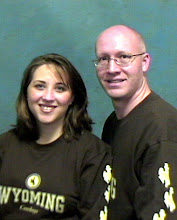We are back.
The weather has been beautiful lately with highs in the 60's most days. Things are really greening up here in the valley but there is still a line a snow across the tops of the Big Horns. Waht a beatutiful view! The apple and the pear trees are just starting to blossom. It should be great for the bees and the bees should be great for the fruit harvest.
Speaking of fruit harvest, we decided to get another apple tree and a couple of cherry trees for the backyard. We had the spots picked for 3 small trees. We bought a Black Tartarian Cherry, a Stella Cherry, and a Honey Crisp Apple. All are semi-dwarf trees so, we thought they would be nice and small- I guess we should have done more research before we got them. After reading about them we found out that they will all grow to about 15 feet in height with a 12 foot spread. Hmmm...Bigger than we thought. We will have to find new spots, but with three big fruit trees think of all those blossoms full of pollen and nectar for the bees. And then all the fruit... farmer's market here we come!
Ok- now for the last inspection. According to "Beekeeping for Dummies" you should do weekly hive inspections for the first 8 weeks. We completed our 2 week (actually 12 day) inspection on Monday the 4th of May. A hive inspection starts with firing up the smoker about 30 minutes before the inspection to give it time to burn down to coals then add more fuel on top so it will smolder and make lots of nice smoke. We have had trouble with the smoker. If handled properly it should keep smoking for a long time. We can't keep it going for more than about 15 minutes or so. Guess we'll just keep practicing
A little more background. Beehives consist of a series of boxes which are open on the top and bottom stacked on top of each other. The bottom 2 boxes, called deep hive bodies, are deeper than the upper boxes and are where the queen lives and lays here eggs. 8-10 frames are stacked in each box. The bees build their comb on each of the frames and use the comb to store honey and pollen and to raise young bees. The queen lays an egg in each cell, the nurse bees feed the larvae, and as the larvae matures the nurse bees cap the cells with wax. Within the capped cells the larvae develop into adult bees, kind of like when a caterpillar develops into a butterfly. Eggs, larvae, and capped pupae are all referred to as brood. Pupae under the wax caps are called capped brood. Smaller boxes called supers go on top the deep hive bodies and are where the bees store extra honey- that will be our honey!
So- when we hived the bees we put each colony in a single deep hive body. As the bees build comb and fill up one box another is added to give them room to expand. We started this inspection with Virginia. We pulled each frame out, looked it over, and put it back in its place. We just needed to see how much room was left and to make sure that they were producing more bees to build up their numbers. We found out the bees had drawn comb on 7 of the 10 frames. Excellent! Time to add a second deep hive body. We also found lots of comb containing stored sugar syrup and pollen. We noticed about three different colors of pollen: orange, yellow, and cream as different flowers have different colors of pollen. The best part, though was seeing how many eggs, larvae, and capped brood there was. I think we are about to have a population explosion. Started with about 15,000 bees in the colony- a well established colony will have 120,000 or more bees. We even saw the queen crawling across one of the combs. We closed Virginia up, added a second deep hive body with 10 more frames, refilled the feeder with more sugar syrup, and moved on to Georgia.
By the time we got to Georgia the smoker was fading. Luckily our bees are so docile they didn't seem to mind the invasion of their hive. Georgia was not as advanced as Virginia. We saw stored sugar syrup and pollen, eggs, larvae, and capped brood, but only 5 frames contained comb and only 3 of the frames had a significant amount. No second hive body for Georgia. We did not see the queen anywhere, but the fact that there were eggs means that she has been around within the last few days. We are sure she was there somewhere.
We were concerned about the slow progress of Georgia. She has always been less active than Virginia. We thought that maybe we had a week queen and that maybe we would need to replace her. After more research and asking opinions of other beekeepers on beesource.com, we discovered that Georgia is about average for the 2 week mark and that Virginia is really taking off. Maybe we should see about getting Virginia into a gifted and talented program.
Now we wait until next week and do it all over again. Can't wait for the fruit trees to come in to full bloom and watch the bees on the blossoms. We are just so proud of those little girls!
Pictures will follow but they will have to wait for another day.
Record Honey Harvest!
6 years ago




0 comments:
Post a Comment